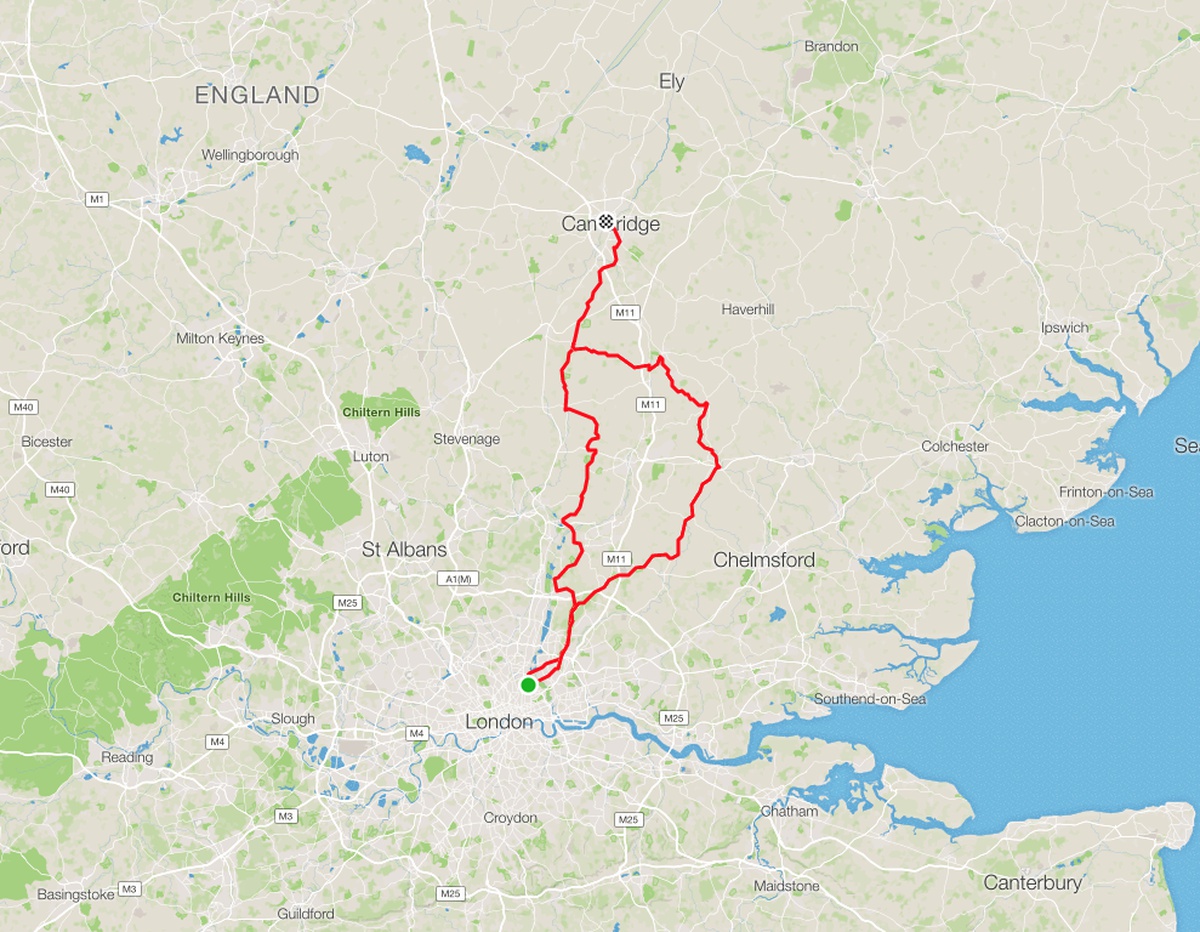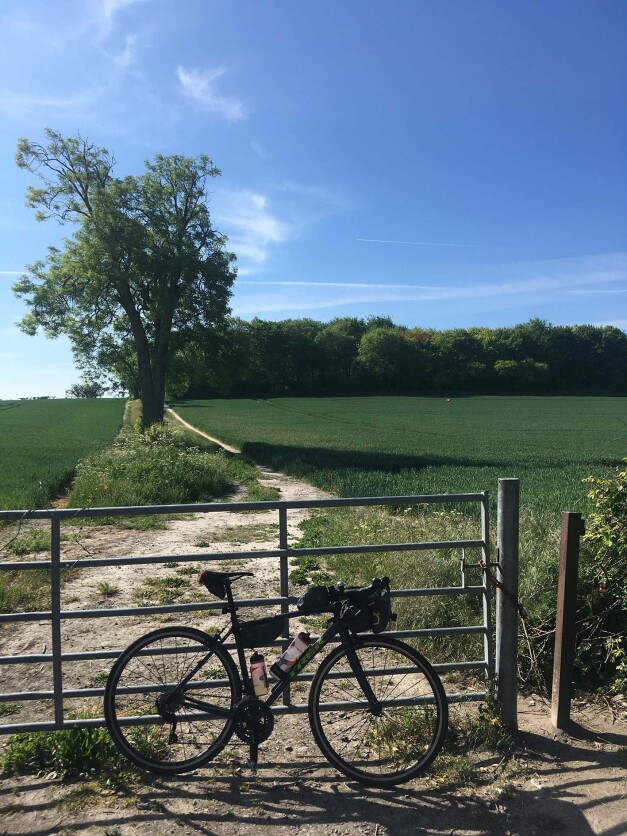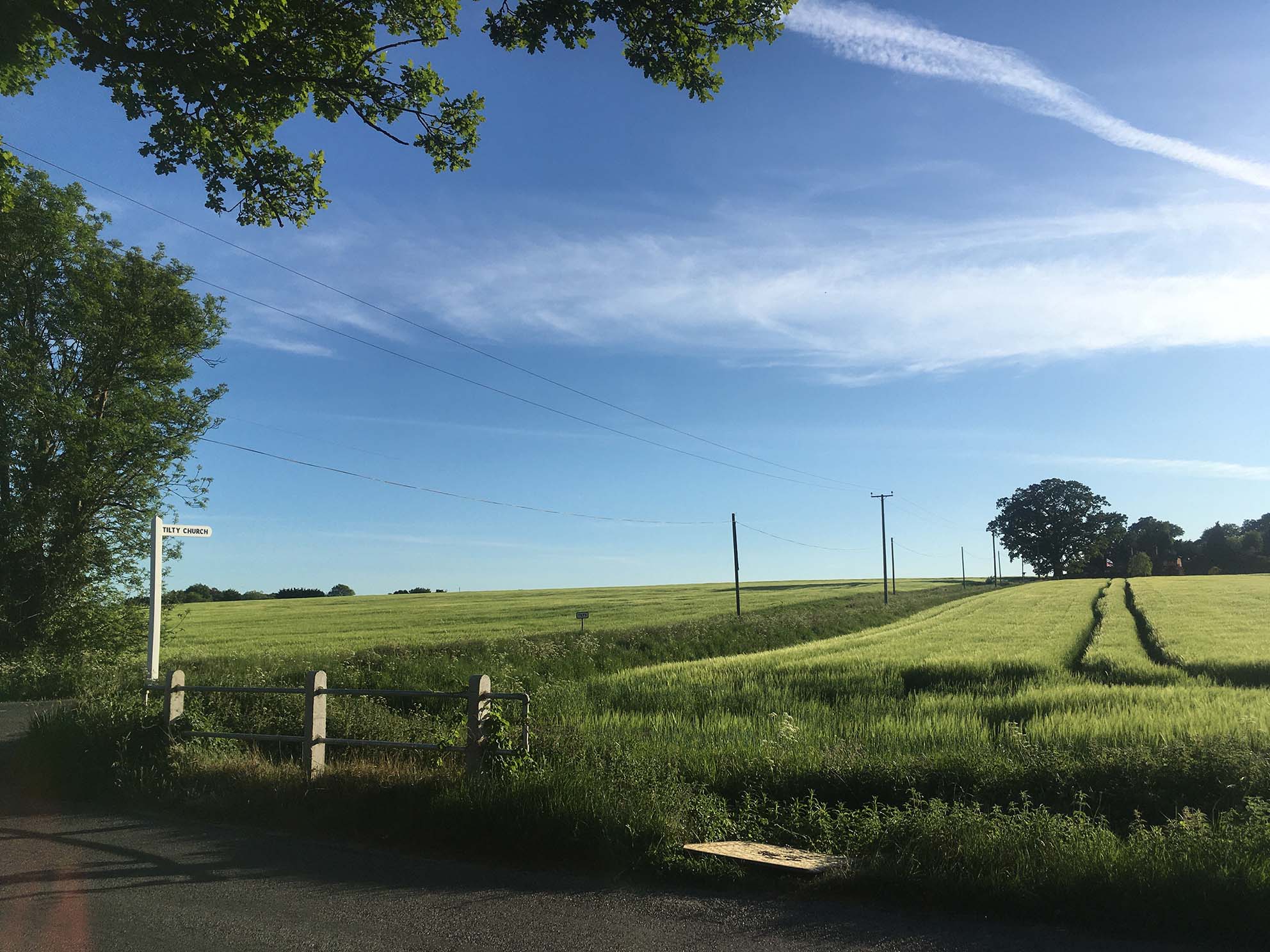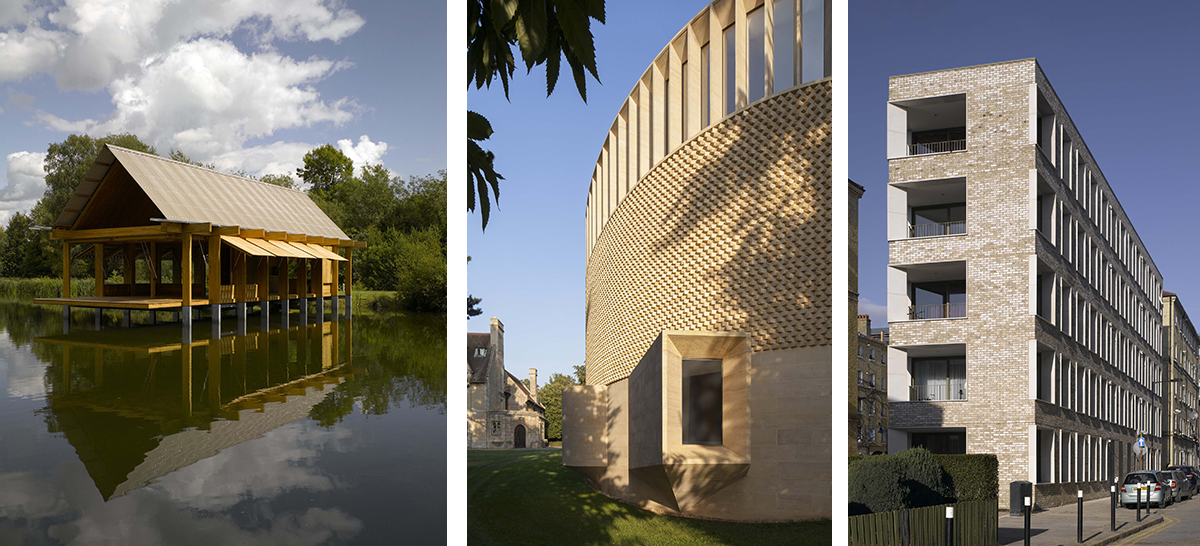CYCLING TO SITE
JUNE 2020

The Coronavirus pandemic has forced us all to adjust our lives and working practices in unexpected ways. Some, perhaps many, of these adjustments are positive, opportunities to see the world in a different way. At the moment, I am working on a small stone building for the choir at Trinity Hall in Cambridge. The site closed for several weeks immediately after the lockdown was imposed, and then reopened in early May. With a small, finely-detailed building like this, remote site inspections would be all but impossible, so I needed to start making site visits again. Pre-pandemic, I was a frequent traveller on the 0742 King’s Cross to Cambridge – but government advice and office policy were clear in saying that public transport should be avoided if at all possible. I don’t drive, and I enjoy long-distance cycling, so decided to cycle to my fortnightly inspections – a 135 mile round trip from my house in Hackney.
A bright sunrise and it’s warm already. Leaving home before six, I cross the Lea Valley and go out through Walthamstow, with swifts screaming above me and not much else for company. Epping Forest is almost deserted, and loud with birdsong. Two mountain bikers cheerily request a tow as I overtake them. Around Harlow, the rush hour is unexpectedly early and vicious, so I am happy to emerge into the quiet lanes and villages of Hertfordshire. On the chalk hills around Much Hadham, where Henry Moore had his studio, I watch a red kite gliding over a field, sunlit against the clear blue sky. After a long, gradual downhill, I cross the flat fen-edges with a tailwind helping me towards Cambridge. Coming into the city, my own route-planning mistake sends me alongside the railway and through the cluttered backstreets of Addenbrooke’s Hospital, rather than along the river through Grantchester Meadows as I had intended. Down the Hills Road and into central Cambridge. Tourists and students are notable by their absence, and the city seems full of builders, including a neat socially-distanced row of men in hi-vis having their tea break on the low wall outside King’s College Chapel.

Gateway near Great Shelford, Cambridgeshire
When I arrive on site, to my relief, nobody bats an eyelid about the architect turning up in Lycra (or at least they are polite enough not to mention it!). I get changed and negotiate a slight delay in my temperature being taken as a COVID precaution, concerned I might be sent straight back again because I am hot from cycling. It’s exciting to see the building progressing again after a long period of inactivity. The masons are as exacting as ever, apologising for their own snags before I spot them, and grumbling about the occasional inaccuracies of the sawing work done at the quarry. It’s fantastic to see the strong sunlight and shadows on the stone surfaces, with arrises and joints we spent so long agonising over in the office as drawings now holding their own as part of the emerging building. I stand on the roof to have an enthusiastic conversation with the window installer about rubber membranes, and then go into the office to talk through some drawings with the site manager, both of us realising it is a challenging task if we are two metres apart with the drawing in the middle.

– The building in progress: Granite plinth and first course of limestone, with the lantern framework above.
– Granite plinth and Portland Stone
– Portland Stone details – Jordans Basebed and Grove Whitbed
– Internal reveals and makeshift masons’ workbench
The inspection and discussions finished, I am wished a safe journey back with a wry smile. I sit on The Backs and eat a large packed lunch, then set off back the way I had come. Near Royston, I turn off and pick up another way home, into Essex and through Saffron Walden. At Debden, I find the village hall tap and wonder if I might drink it dry. Riding along in the evening sun, the long day catches up with me and I stop for a nap at the edge of a dry, cracked field of wheat. Carrying on into a steady headwind, Thaxted looks beautiful, with its windmill, buttressed church tower and medieval timber-framed houses. Approaching London, the roads are familiar from the rides that have kept me sane during lockdown, and I roll back through Epping Forest just as the sun is sinking over the horizon. The Lea Bridge Road is a bit of a shock to the system after so many miles of quiet sunlit lanes, so I spin along quickly and arrive home for a cold beer and some supper, ready for a ‘normal’ day working from home tomorrow.

Fields near Tilty, Essex
A STYLE FOR OUR TIMES?
NOVEMBER 2015

“The way to make good architecture – that is, to respond with dignity to the relentless jostling of theoretical positions and of the buildings themselves – can be to say very little indeed and just to enquire into what a particular place might, by way of buildings, most need”
Niall Hobhouse in Translations: Florian Beigel and Philip Christou, Christoph Merian Verlag 2014
Each year the Stirling Prize shortlist sparks debate about contemporary architectural style and it was no different this year, particularly with such a distinctive set of buildings. The prize is “presented to the architects of the building that has made the greatest contribution to the evolution of architecture in the past year” and so any building shortlisted could be considered to exemplify a style for our times.
In practicing architecture I have been conscious of past and present styles or trends and how these influence design. The offices I have worked in each have different design styles and a different set of architectural references. This variety has enriched my experience of design; as a result, I do not consider myself to have a fixed stylistic agenda or claim a particular preference for one style over another.
I have now been at NMLA for almost a year, working on one project but well aware of the rich variety in the practice’s past and present portfolio. Whilst there may be a discernible common language in the architecture, I would say this transcends any one particular style. To pick three of the most celebrated projects, the Chapel at Ripon College is very different to the Fishing Hut which is very different to Darbishire Place. Of course these buildings have different briefs but perhaps their ‘style’ is most significantly determined by the ‘place’ they inhabit (where ‘place’ refers to location and context – physical, social, historical and political).
The Chapel sits on a sensitive site. It must respond to its bucolic setting in a clearing amongst trees, the historically-significant college building stock behind and the views to and from the valley below. The Clipsham stone is in keeping with the Limestone of the other college buildings. The smooth base helps ground the building in its natural setting whilst the rough-cut dog-toothed stone alludes to the craft evident in the historic buildings nearby and has an organic quality whose textured surface perfectly captures the shadows of the trees. The clerestorey windows glow as a halo and act as a beacon on the hill when seen from the valley below. Rowan Moore described the chapel as sitting “comfortably amid Cotswold scenery and gothic revival architecture”.
The Fishing Hut is set in the landscape, between water and sky. Its simple form and construction are familiar to rural or agricultural settings but the level of craft and its quality materials make it delightful for the user, elevating it beyond purely functional. With its operable screens and shutters, it is both solid and transparent, as much about shelter, security and shade as it is about light, air and opening up to the landscape it inhabits.
At Darbishire Place the new brick block reflects the massing and characteristics of the existing Peabody estate blocks. The brick selection and white precast concrete window surrounds complement the brick and white-painted window reveals of the Edwardian buildings around the courtyard. Inset balconies enable the new façades to have a flatness akin to those of the surrounding buildings. A simple kink in building’s footprint allows the block to work with its context on both sides – a longer elevation addresses the street while a more compact elevation works with the proportions of the other courtyard façades. This kink also provides a route in from the street and so the new block can complete the courtyard without closing it off.
In terms of these three buildings, it is perhaps more difficult to identify a common architectural language than to comment on how they respond to place. I think they are all concerned with light and shadow and each display a level of craft in their execution. For me though the architecture of each project has a fineness. The fragile crown of stone fins and frameless clerestorey windows at the top of the chapel; the intricate timberwork, lightweight permeable envelope and the slight cantilevered deck hovering over the water to the front of the fishing hut; and the open corners and slender corner posts containing the inset balconies to Darbishire Place. It is these moments of finesse that unite the three buildings and other projects in the office.
Style has played an important and often polemical role in the development of architecture over the last 150 years. However, whilst we can entertain debate about a cycle of trends in design, what style is ‘now’ and what is coming next, it seems more pertinent to be aware of the wide variety of styles and take influence from sources that are most appropriate to any one project’s place.
In the same vein as the opening quotation, we should not be concerned with a particular style for a particular time, but rather a particular style for a particular place.




